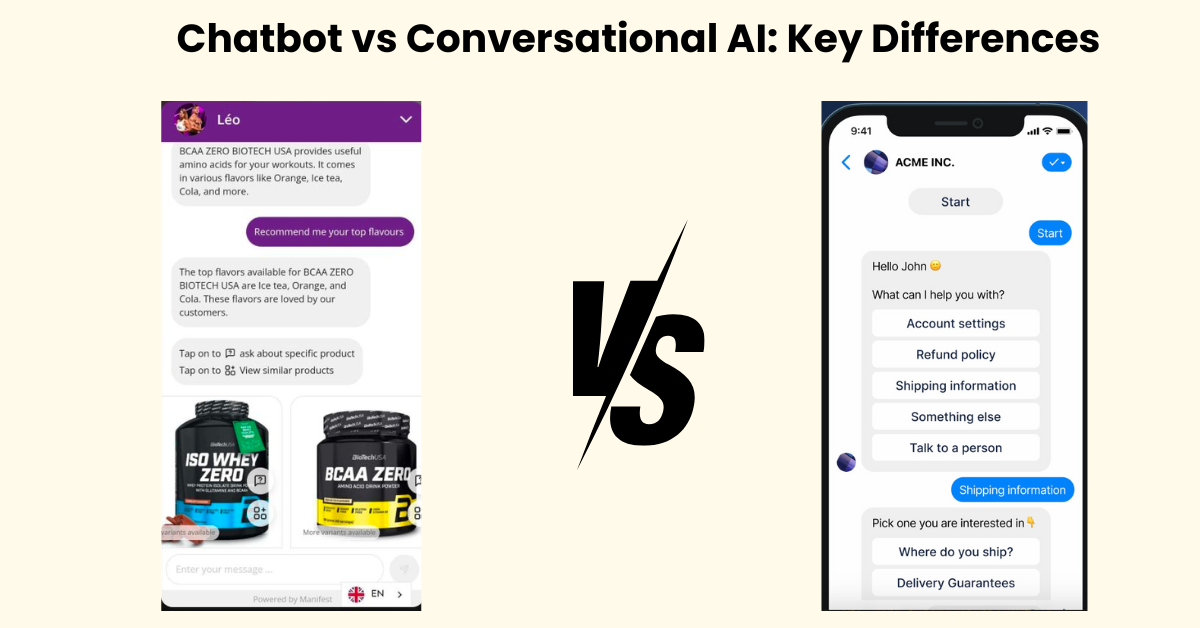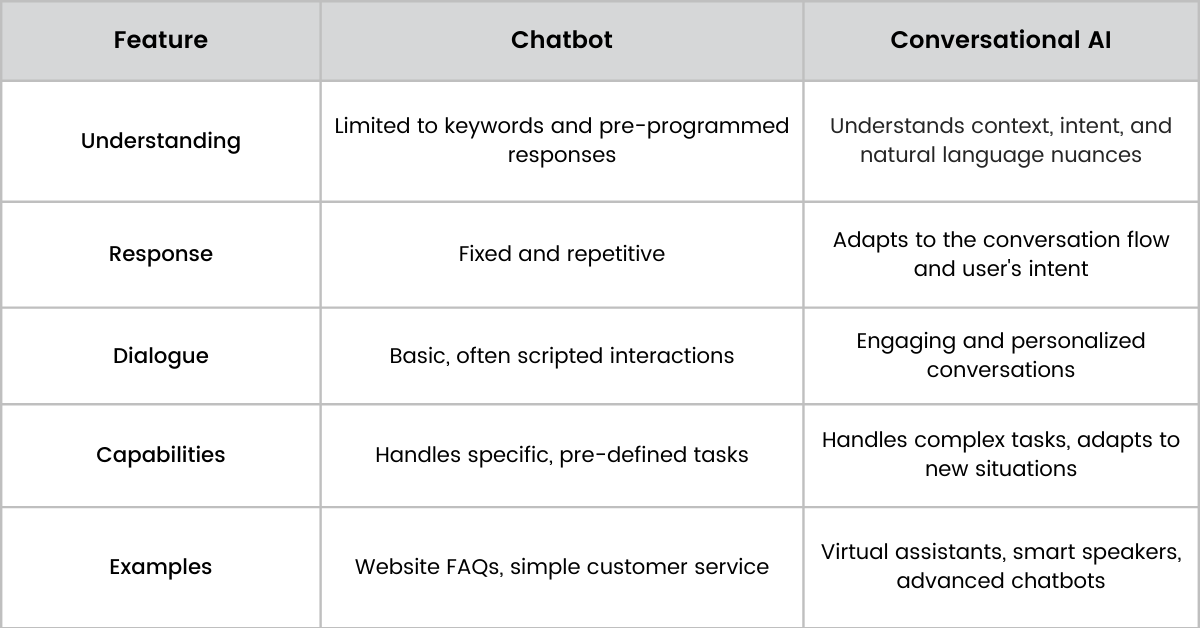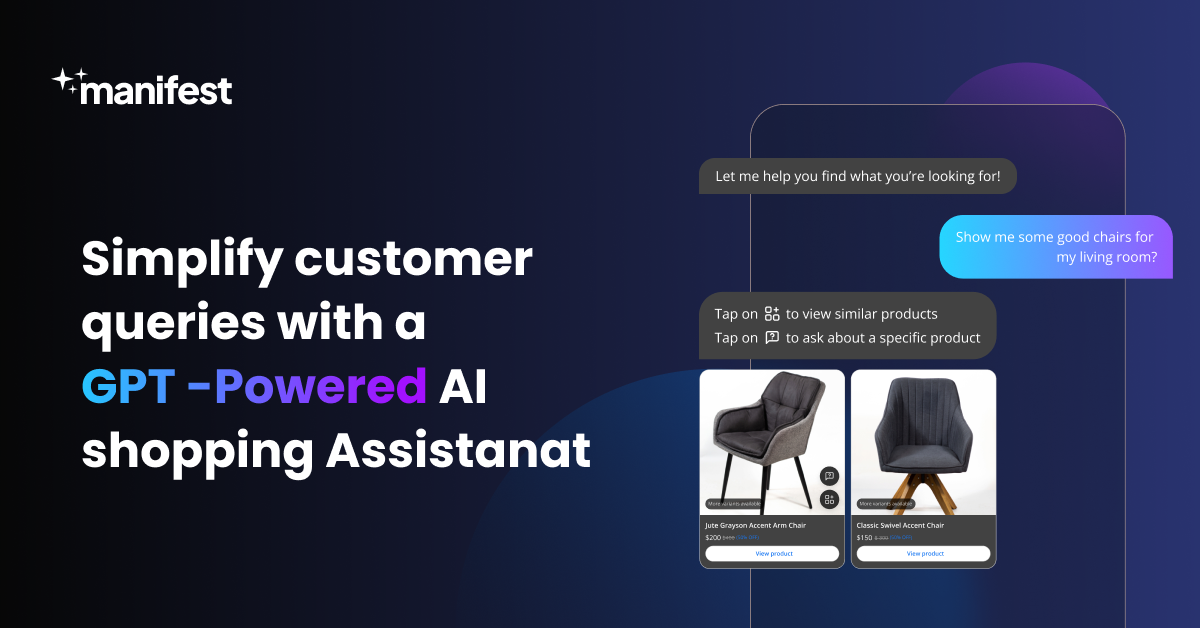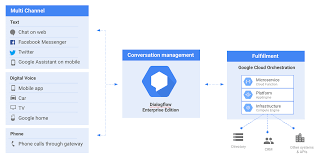Chatbot vs Conversational AI: Key Differences

While often used interchangeably, chatbots and conversational AI represent distinct concepts. Think of chatbots as helpful assistants, following predefined rules to answer your questions. However, their capabilities are limited, and straying outside their programmed knowledge results in generic responses.
Conversational AI, on the other hand, opens up a whole new world. These intelligent systems understand and respond to human language in a much more sophisticated manner, making them truly capable conversational partners.
Let's discuss deeper into the fascinating concept of chatbot vs conversational AI, exploring their unique characteristics and uncovering the key differences that set them apart.
Chatbot vs Conversational AI: Introduction
Here is a brief introduction to conversational AI and chatbots:
Chatbot
Chatbots are software programs emulating human conversation through text or voice. They function as friendly assistants, answering specific questions and completing tasks. chatbots operate according to predetermined rules, matching user requests with pre-programmed answers. Their strength is in dealing with routine questions, but they struggle with anything beyond their knowledge base.
Despite their limitations, chatbots provide ease and efficiency, particularly for repetitive jobs. They can be found on websites, chat apps, and even smart speakers in your house.
Conversational AI
Conversational AI is an advanced form of artificial intelligence that goes beyond ordinary chatbots. conversational AI-based bot employs natural language processing and machine learning to comprehend and respond to human language in a sophisticated and nuanced manner. AI conversational bot, unlike chatbots, can engage in meaningful communication, adapting to the flow of the conversation and comprehending the user's intent. This enables engaging and individualized experiences, making it useful in a variety of applications such as customer service, education, and entertainment.
Chatbot vs Conversational AI: Comparison chart
Let's discuss the comparison chart of Conversational AI vs Chatbot:

Chatbots vs Conversational AI: Applications in Customer Service
Both chatbots and conversational AI are transforming the customer service landscape, but they offer distinct advantages and limitations:
Chatbot Strengths & Limitations
Strengths:
24/7 Availability: Chatbots operate non-stop, providing customers with support at any time of the day. This is particularly beneficial for businesses with a global customer base in different time zones.
Efficiency: Chatbots excel in handling routine and repetitive tasks, such as providing order status or resetting passwords. This frees up human agents to focus on more complex and high-value tasks, improving overall efficiency.
Cost-Effectiveness: By automating routine tasks, businesses can reduce the need for a large customer support team, leading to significant cost savings. Chatbots allow companies to allocate human resources more strategically, focusing on tasks that require emotional intelligence and problem-solving skills.
Multilingual Support: With the ability to communicate in multiple languages, chatbots break down language barriers and cater to a diverse customer base. This is crucial for businesses operating on a global scale or serving customers from different linguistic backgrounds.
Limitations:
Limited Understanding: Chatbots may struggle to fully grasp the nuances of human language, leading to misinterpretations of customer queries. This can result in frustration for customers who expect a more nuanced and context-aware interaction.
Inability to Handle Complex Issues: While effective for routine tasks, chatbots may struggle with complex issues that require critical thinking, creativity, or a deep understanding of a specific situation. In such cases, human intervention becomes necessary for a satisfactory resolution.
Repetitive and Scripted Interactions: Chatbots often rely on predefined scripts and responses, making interactions predictable and potentially impersonal. Customers may prefer a more natural and dynamic conversation, which can be challenging for chatbots to emulate.
Depersonalization Impact: Chatbots may not provide the personalized touch that human agents can provide due to their lack of AI in chatbots and their scripted nature. Customers may feel as if they are interacting with a machine rather than receiving personalized attention if there is a lack of customization.
Conversational AI Strengths & Limitations
Strengths:
Natural Language Processing: Conversational AI systems leverage advanced natural language processing (NLP) capabilities to understand the context and intent behind customer inquiries. This enables more accurate and personalized responses, enhancing the overall effectiveness of customer interactions.
Open-Ended Conversations: Unlike traditional chatbots, Conversational AI can engage in natural and open-ended dialogues. This allows it to handle complex and nuanced issues, making it suitable for a wider range of customer queries and concerns.
Sentiment Analysis: Conversational AI systems equipped with sentiment analysis can detect the emotional tone of customer interactions. By understanding customer sentiments, the AI can adapt its communication style accordingly, demonstrating empathy and improving the overall customer experience.
Personalization: One of the key strengths of Conversational AI is its ability to tailor responses to individual customer needs and preferences. This personalization fosters stronger relationships between the customer and the business, as interactions feel more customized and relevant.
Limitations:
Higher Development Cost: Building and implementing Conversational AI solutions can be more resource-intensive compared to basic chatbots. The development cost is higher due to the need for advanced technology, substantial training data, and ongoing maintenance. This can be a barrier for smaller businesses with limited budgets.
Privacy Concerns: The collection and analysis of customer data for personalization purposes may raise privacy concerns. Customers may worry about the security of their information and the potential misuse of personal data. Addressing these concerns is crucial to building trust and ensuring compliance with privacy regulations.
Limited Availability: While Conversational AI has made significant advancements, its widespread adoption is still in progress. Technology is continuously evolving, and businesses may face challenges in finding or developing solutions that suit their specific needs. As the technology matures and becomes more accessible, broader availability is expected.
Chatbot vs Conversational AI: Examples
Here are traditional Chatbot and conversational AI chatbot examples:
Chatbot Examples

A conversational marketing platform that uses chatbots for qualifying leads, booking meetings, and providing a personalized customer journey.

Offers chatbot solutions for customer support, marketing, and sales, focusing on personalized customer communications.

Specializes in AI-powered conversational commerce, helping businesses connect with customers via messaging.

A chatbot platform for Facebook Messenger, allowing businesses to automate responses and engage with customers.

Provides live chat and messaging services, enhancing customer service with quick, efficient communication.
Conversational AI Examples
- Manifest AI

Manifest AI stands out as a top-tier conversational AI tool, especially tailored for Shopify stores. It leverages GPT-powered AI to provide highly personalized and interactive customer experiences. Manifest AI excels in understanding and responding to customer queries in a natural, human-like manner, enhancing customer engagement and support on e-commerce platforms. Its integration with Shopify allows for seamless implementation, making it an ideal solution for store owners looking to elevate their customer service and interaction capabilities with advanced AI technology.

An advanced AI assistant that builds conversational interfaces into applications and devices.

Enables users to design natural conversational experiences, supporting chat or voice interfaces.

Offers tools and services for building conversational AI experiences across multiple channels.

An open-source platform for building contextual AI assistants and chatbots, focusing on more complex, conversational capabilities.
The Future of Chatbots vs Conversational AI
In the future, both chatbots and conversational AI will grow more intelligent and individualized. Chatbots will be able to handle more complicated inquiries, integrate with other technologies, and specialize in particular tasks. Conversational AI will grasp human emotions and offer proactive support, effortlessly merging with business operations. In general, the future is collaborative, with chatbots and conversational AI collaborating to improve human-computer interaction.
Conclusion
Finally, chatbots and conversational AI are two different methods to human-machine interaction. Conversational AI, as opposed to chatbots, uses modern technology such as machine learning and natural language processing to produce dynamic and natural discussions. As conversational AI advances, it will provide tremendous benefits in terms of customization, engagement, and, eventually, customer pleasure. Chatbots, on the other hand, have a role in circumstances where simple, programmed conversations are sufficient. Finally, the decision between a chatbot and conversational AI will be determined by the specific demands and goals of each enterprise.
FAQs
What is an example of Conversational AI?
Siri, Apple's virtual assistant, is one of the most well-known examples of Conversational AI. Siri understands and responds to a wide variety of voice commands, including those for setting alarms, making phone calls, playing music, and answering inquiries. Google Assistant, which is available on Android devices and Google Home speakers, is another example. The Assistant can also recognize and respond to a variety of voice queries and operate smart home devices.

.png)
